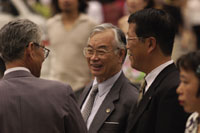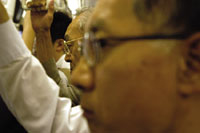Kobe's Quandary: Robots versus Revolution
Back to Contents of Issue: October 2003
|
|
|
|
by Dominic Al-Badri |
|
 JAPAN IS GETTING OLD -- and fast. By the year 2020, the percentage of the nation's population over 60 is set to reach 30 percent, the highest in the world. Japan also lays claim to another dubious record: In the year 2007, Japan will be the first country to host a naturally declining population (i.e. one in which the decline is not the result of war). Other western nations are set to follow suit. But by the middle of the century, UN demographic estimates show that Japan's population will be 30 percent smaller than it is now, with some 800,000 more people dying than being born each year.
JAPAN IS GETTING OLD -- and fast. By the year 2020, the percentage of the nation's population over 60 is set to reach 30 percent, the highest in the world. Japan also lays claim to another dubious record: In the year 2007, Japan will be the first country to host a naturally declining population (i.e. one in which the decline is not the result of war). Other western nations are set to follow suit. But by the middle of the century, UN demographic estimates show that Japan's population will be 30 percent smaller than it is now, with some 800,000 more people dying than being born each year.
Some might say that that's not a bad thing, as it will help relieve population pressures on this hellishly overcrowded archipelago (5,000 people/km2 of arable/habitable land). But the reality is that the economic and social costs are going to have to be paid for long before 2050 comes around.
At the end of July, a series of seminars and workshops was held in Kobe under the auspices of the Asian Urban Information Center of Kobe (AUICK). Featuring delegates from nine developing Asian countries and a number of heavyweight speakers, the one-week event focused on population and sustainable development issues. Japan takes the regional lead in research in this broad field, specifically in the field of population aging and community care.
The commonly held impression of many developing Asian countries is one of populations spiraling out of control. Yet thanks to improved health care and population-planning measures, life expectancy is rising rapidly and fertility rates are declining. By 2020, both China and India (the world's most populous countries) are projected to have total fertility rates (TFR -- the number of children born per woman) only marginally higher than those in the US. In China's case the TFR value is expected to be 2, less than the 2.1 needed to sustain a population at its current levels. In other words, come 2020, even China's overall population is going to be decreasing.
Fertility
Japan's life expectancy figures continually rank at or near the top of the global tree. When it comes to healthy life expectancy (i.e. the number of years a person can expect to live, disease- or disability-free), Japan has no contest. Good as this might be for the individual, the socio-economic costs have only begun to be considered.
A recent pronouncement by Finance Minister Shiokawa Masajuro about the collapse of the national pension fund due to the increasing elderly population has done little to reassure the public, even though Shiokawa later retracted his statements.
Dr. Hiroshi Ueda, of the World Health Organization Kobe Centre, explains the reasons behind this trend toward longevity. "We are seeing an epidemiological transition. The changing pattern of diseases is significant: There is a decrease in communicable diseases at the same time as the incidence of non-communicable diseases is increasing. This effect, coupled with the advancement of medical technology, means people are living much longer than before."
The central tenet of the WHO's health policy since 1978 has been that of primary health care (PHC), essentially "care which provides integrated, accessible health care services by clinicians who are accountable for addressing a large majority of personal health care needs, developing a sustained partnership with patients, and practicing in the context of family and community." But 25 years after its adoption, and partly a victim of its own success, PHC is under great strain in aging societies, as financial sustainability becomes a pressing issue. Furthermore, PHC doesn't take into account the effects of the epidemiological transition now being witnessed in both the developed world and increasing parts of the developing world -- specifically Asia.
In Japan, the proportion of demented, frail and bedridden elderly persons is set to double between now and 2025, accounting for about 5 percent of the elderly population.
"There are numerous socio-economic issues which must be considered," says Ueda. "These include an increase in public social spending, higher health expenditure, rising gender disparities due to different life expectancies between men and women and dips in the labor force."
One of the main fields Ueda and other staff at the WHO Kobe Centre are working on is a new paradigm to replace the increasingly unworkable PHC model.
The concept closest to fruition is called Community Health Care, which aims to build on the successes of PHC but seeks to place them in the context of the family and the community -- integrating health and welfare services (agencies, organizations and institutions like hospitals) with larger, societal ones (legislation and social security). More than just a health care plan, this is a blueprint for social revolution.
Unworkable
By 2015, a quarter of all Japanese citizens will be over 65 and there will be less than two people at work for every retiree. The US, with its progressive attitude toward immigration (1 million people a year), isn't staring the same problem in the face. In notoriously insular Japan, however, where barely 1 percent of the population is non-Japanese -- and even that figure is made up of mostly ethnic Koreans and Chinese born and bred here -- the thought of mass immigration by swarms of foreigners is enough to send shockwaves coursing through the nation's conservative elites.
No wonder there have been urgent calls for Japan's world-leading robotic researchers to get cracking with their R&D, so that battalions of Jetsonesque home-helpers and construction workers will remove the need to import millions of foreigners and their smelly food.
But even that doesn't tackle the problem. The initial effects of the aging society in Japan will be an increased demand for geriatric and long-term health care. The nation is already entering this stage. The more worrying implications are a generation away.
"Along with the increased labor shortages, there will be an erosion of the nation's savings surplus and a reversal of the trade surplus. The labor shortage issue will only be able to be dealt with by relocating an ever-increasing amount of industry abroad, or by importing, on a massive scale, foreign workers," said Ueda.
Japan is clearly unprepared for a massive influx of foreigners. Equally inconceivable is the idea that robot workers could replace humans within a generation or two. Yet as whiffs of a resurgent militarism emanate from the halls of Nagatacho, the increasing socio-economic pressures faced by an aging Japan may lead to a very different kind of social revolution -- one in radical opposition to the benign visions of Ueda and his kin. @ |
|
Note: The function "email this page" is currently not supported for this page.


 By 2050, China is expected to have nearly 350 million people over the age of 65. India won't be far behind, with a projected 240 million citizens all clamoring for their pensions. In total, a staggering 14 percent of Asia's population will be over 65. With health care expenditure per person over 65 at levels between two and five times that for people under 65, it's clear that it's not just the Japanese archipelago facing a massive problem, but the entire Asian continent. Will it be able to provide health care to such vast numbers of the aged?
By 2050, China is expected to have nearly 350 million people over the age of 65. India won't be far behind, with a projected 240 million citizens all clamoring for their pensions. In total, a staggering 14 percent of Asia's population will be over 65. With health care expenditure per person over 65 at levels between two and five times that for people under 65, it's clear that it's not just the Japanese archipelago facing a massive problem, but the entire Asian continent. Will it be able to provide health care to such vast numbers of the aged?



